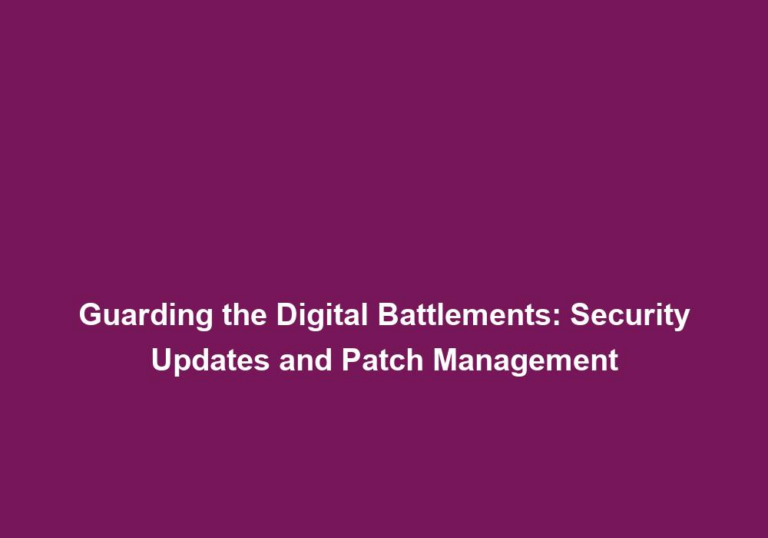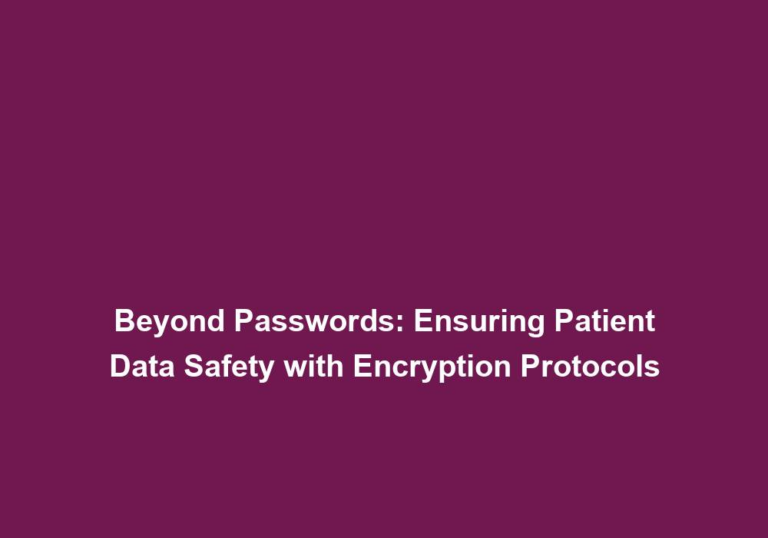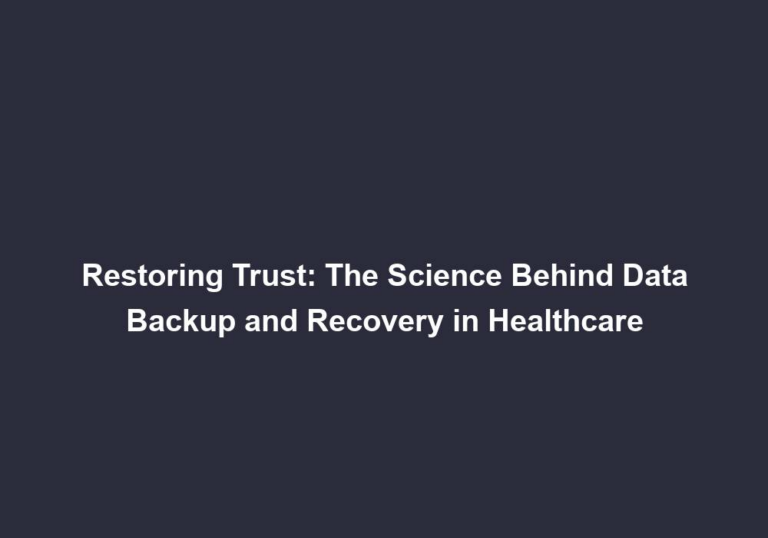The Heartbeat of Healthcare: Secure Digital Patient Data Management
In today’s digital era, the healthcare industry is increasingly relying on technology to manage, store, and exchange patient data. With the rapid advancements in digital health systems, it has become paramount to ensure the secure management of this sensitive information. This article explores the importance of secure digital patient data management and the measures healthcare providers must take to protect patient privacy.
The Significance of Secure Digital Patient Data Management
- Enhancing Patient Privacy: Protecting patient privacy should be a top priority for healthcare organizations. Secure digital patient data management ensures that personal health information (PHI) remains confidential, safeguarding patients’ sensitive data from unauthorized access or breaches.
Secure digital patient data management is essential for enhancing patient privacy. By implementing robust security measures and following best practices, healthcare organizations can protect personal health information (PHI) from unauthorized access or breaches. This includes ensuring that patient data is encrypted both during transit and at rest, adopting strong authentication protocols, and conducting regular security audits. By prioritizing patient privacy, healthcare providers can build trust with their patients and foster a strong doctor-patient relationship.
- Improved Healthcare Delivery: Effective data management enables healthcare providers to access patient records promptly, leading to more efficient healthcare delivery. This streamlined approach allows medical professionals to make informed decisions, provide accurate diagnoses, and tailor treatment plans to individual patients’ needs.
Secure digital patient data management not only enhances patient privacy but also improves healthcare delivery. By securely storing and managing patient data, healthcare providers can access records promptly and efficiently. This helps medical professionals make informed decisions, provide accurate diagnoses, and tailor treatment plans to meet the individual needs of their patients. This streamlined approach leads to improved healthcare outcomes and enhances the overall patient experience.
- Empowering Medical Research: Digital patient data management plays a pivotal role in advancing medical research. By securely storing and analyzing vast amounts of patient data, researchers gain valuable insights into disease patterns, treatment effectiveness, and emerging healthcare trends. These findings contribute to the development of innovative therapies and improved healthcare outcomes.
In addition to enhancing patient privacy and improving healthcare delivery, secure digital patient data management empowers medical research. By securely storing and analyzing large volumes of patient data, researchers can gain valuable insights into disease patterns, treatment effectiveness, and emerging healthcare trends. This data-driven approach allows researchers to identify potential breakthroughs, develop innovative therapies, and improve healthcare outcomes. It also facilitates collaboration between researchers and healthcare providers, leading to advancements in medical knowledge and the development of evidence-based practices.
Ensuring the Security of Digital Patient Data
To ensure the security of digital patient data, healthcare organizations must implement robust measures and adhere to industry best practices. Here are some key considerations:
1. Implementing Strong Authentication Protocols
- Adopting multi-factor authentication methods, such as combining passwords with biometric identifiers (fingerprint or facial recognition), adds an extra layer of security and prevents unauthorized access to patient data.
- Regularly updating and strengthening passwords helps protect against brute-force attacks and unauthorized access.
Implementing strong authentication protocols is crucial to safeguarding digital patient data. Healthcare organizations should adopt multi-factor authentication methods that combine passwords with biometric identifiers like fingerprint or facial recognition. This adds an extra layer of security and prevents unauthorized access. Regularly updating and strengthening passwords further enhances data security by protecting against brute-force attacks and unauthorized access attempts.
2. Encrypting Patient Data
- Encrypting patient data both during transit and at rest is crucial in safeguarding sensitive information. Encryption converts data into an unreadable format, making it inaccessible to unauthorized individuals.
- Employing end-to-end encryption in communication channels, such as emails or telemedicine platforms, ensures patient data remains secure throughout the transmission.
Encrypting patient data is a vital component of secure digital patient data management. Healthcare organizations should implement encryption measures to protect sensitive information both during transit and at rest. Encryption converts data into an unreadable format, making it inaccessible to unauthorized individuals. Employing end-to-end encryption in communication channels, such as emails or telemedicine platforms, ensures that patient data remains secure throughout the transmission process, further enhancing data protection.
3. Conducting Regular Security Audits
- Regular security audits help identify vulnerabilities in digital patient data management systems. By conducting comprehensive assessments, healthcare organizations can proactively address potential security gaps and implement necessary improvements.
- Audits should encompass network security, data access controls, encryption protocols, and staff training on data protection best practices.
Regular security audits are essential to maintain the integrity of digital patient data management systems. Healthcare organizations should conduct comprehensive assessments to identify vulnerabilities and address potential security gaps. Audits should cover various aspects, including network security, data access controls, encryption protocols, and staff training on data protection best practices. By proactively addressing security weaknesses, healthcare organizations can enhance the overall security posture and protect patient data from potential threats.
4. Implementing Role-Based Access Controls (RBAC)
- Role-Based Access Controls assign specific permissions and privileges to individuals based on their roles within the healthcare organization. This ensures that only authorized personnel can access and modify patient data.
- Healthcare providers should regularly review and update access controls to reflect staff changes and maintain data integrity.
Implementing Role-Based Access Controls (RBAC) is crucial to ensuring the security of digital patient data. RBAC assigns specific permissions and privileges to individuals based on their roles within the healthcare organization. This ensures that only authorized personnel can access and modify patient data, reducing the risk of unauthorized access or data breaches. It is essential for healthcare providers to regularly review and update access controls to reflect staff changes and maintain data integrity. This helps prevent unauthorized access and ensures that patient data remains secure.
5. Training Staff on Data Protection
- Educating healthcare staff on data protection best practices is essential to prevent accidental data breaches. Training programs should cover topics such as recognizing phishing attempts, securely handling patient data, and proper password management.
- Regular refresher courses and ongoing awareness campaigns reinforce the importance of data security among staff members.
Training healthcare staff on data protection best practices is crucial to prevent accidental data breaches and ensure the security of patient data. Healthcare organizations should provide comprehensive training programs that cover topics such as recognizing phishing attempts, securely handling patient data, and proper password management. Regular refresher courses and ongoing awareness campaigns reinforce the importance of data security among staff members, ensuring a culture of security within the organization.
Best Practices for Secure Digital Patient Data Management
To effectively manage and protect digital patient data, healthcare providers should adopt the following best practices:
-
Regular Data Backups: Implementing automated, encrypted data backup solutions ensures that patient data remains accessible even in the event of system failure or cyber-attacks. Regular backups help mitigate the risk of data loss and enable quick recovery, ensuring the continuity of patient care.
-
Robust Firewalls and Intrusion Detection Systems (IDS): Deploying firewalls and IDS helps prevent unauthorized access to the healthcare organization’s network, detecting and mitigating potential security breaches. Robust firewalls and IDS act as the first line of defense, monitoring network traffic and identifying suspicious activities that may indicate a security threat.
-
Secure Software Development: Healthcare providers should prioritize secure coding practices when developing or implementing software applications that handle patient data. Regular software updates and patches are crucial to address potential vulnerabilities. Secure software development practices help minimize the risk of exploitable software vulnerabilities and ensure the integrity and security of patient data.
-
Secure Cloud Storage: Leveraging secure cloud storage solutions with strong encryption and access controls provides a reliable and scalable option for storing large volumes of patient data. Healthcare organizations should select reputable cloud service providers that prioritize data security and compliance with industry regulations.
-
Data Retention Policies: Establishing clear data retention policies ensures that patient data is retained for the appropriate period, while also considering privacy regulations and legal requirements. Secure and proper disposal of data should also be implemented when necessary to prevent unauthorized access to outdated or unnecessary patient information.
-
Continuous Staff Training: Keeping healthcare staff up to date with the latest data protection practices and regulations ensures a culture of security within the organization. Regular training sessions, workshops, and awareness campaigns help educate staff members on emerging threats and equip them with the knowledge and skills to protect patient data effectively.
-
Vendor Security Assessments: Conducting thorough security assessments of third-party vendors and service providers guarantees that they adhere to the same rigorous data protection standards. Healthcare organizations should evaluate vendors’ security practices, policies, and procedures to ensure the security and confidentiality of patient data throughout the entire supply chain.
In conclusion, secure digital patient data management is the heartbeat of healthcare in the modern age. By prioritizing patient privacy and implementing robust security measures, healthcare organizations can ensure the confidentiality, integrity, and availability of patient data. Embracing best practices and staying vigilant against emerging threats will enable the healthcare industry to leverage the full potential of technology while safeguarding patient information.







